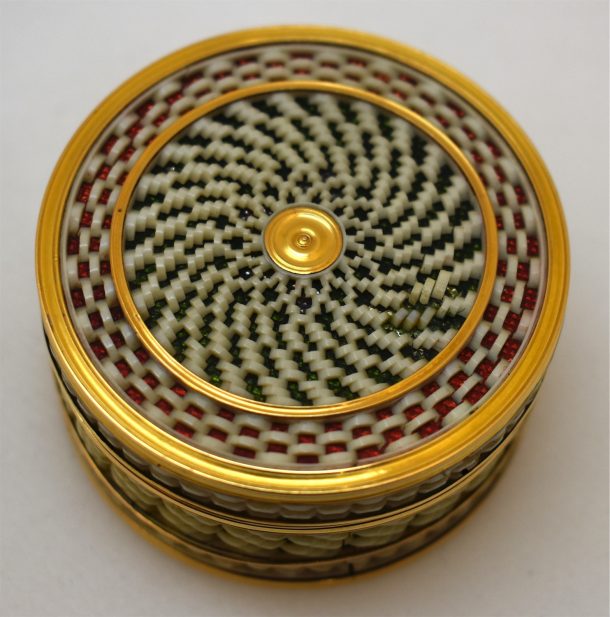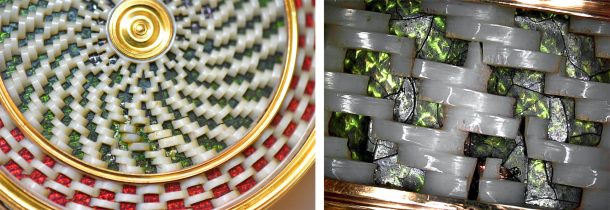I joined the Gilbert team in mid-September 2019 to assess and, if necessary, undertake conservation work on 120 objects in preparation of an exhibition called ‘Masterpieces in miniature’. These objects are destined to travel to several different cities and will allow a selection of the Gilbert Collection to be shared with the wider world.
Once the curator has selected the objects it becomes the responsibility of the conservator to assess them for their suitability to travel. This decision is often more complex when an object is comprised of more than one contrasting material.

One such object in the Gilbert collection is a bonbonnière, a small box meant to contain ‘bonbon’ (sweets, or indeed anything its owner prefers). It was made in Paris in 1767 – 8, by the goldsmith Louis-Claude Porcher. The box is made of ivory in a very unusual concentric pattern created in a process called ‘engine turning’ (the ivory has been turned on a lathe to produce the patterns). The ivory is set over a white metal foil that has been coated with a translucent resin coloured red and green. The resin was analysed by Brenda Keneghan in the Science department using FTIR (Fourier-transform infrared spectroscopy); and found to be gum arabic; the interior of the box and lid has been lined with a gold sheet.

The first stage of any assessment is a visual examination. The ivory showed some signs of damage commensurate with age. It appears to have shrunk, slightly, with the result that there are a number of fractures and several minor losses; there are also some small areas missing from the resin. However, all the surviving elements seem to be stable and not at risk of further damage if handled and displayed with care. It is a rare example of a French ivory box and, though fragile, an ideal candidate for the exhibition.
Under magnification, the true extent of the damage became clear. The resin is severely cracked across most of the surface, it is also evident that the resin has been consolidated in the past to try to prevent further losses. The ivory also has many more cracks than we originally suspected.
As a metal, gold expands and contracts according to temperature. This expansion and contraction may be on a minute scale but, with the resin in such poor condition, it is possible that this would have resulted in further losses. Changes in humidity will cause the ivory to expand and contract, again leading to potential loss. In addition to the inevitable changes in temperature and humidity conservators must also consider the risk to the object caused by vibrations which will occur during transit and the additional handling of the object necessary for an exhibition.
I discussed the fragile nature of the box was with Alice Minter, curator of the Gilbert Collection at the V&A, we eventually decided – sadly – to withdraw this object from the tour. The changes in temperature and humidity might have resulted in further cracking or even losses to both the ivory and the gum arabic beneath. There is always disappointment when an object is deemed too fragile to travel, and it is not a decision we made lightly. The risks must be weighed against the benefits of displaying it, but in this case the risk to further damage of this object was too great.
A positive ending to this is that another equally exquisite object will be chosen to go on tour in place of this one. Additionally, the Porcher bonbonnière will be hopefully on display soon in our permanent galleries. More information and detailed photographs are available on the V&A collections page.


